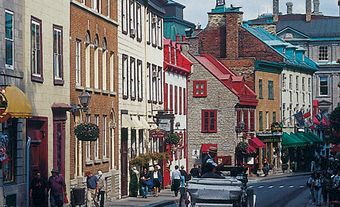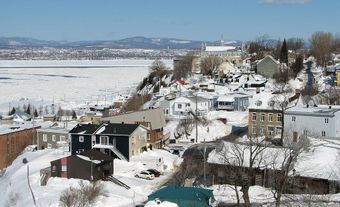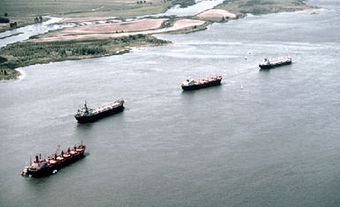Saint-Romuald, Quebec, population 13,435 (2019), 10,825 (2001 census). Originally incorporated in 1965, Saint-Romuald is located on the south shore of the St. Lawrence River. It is across from Sillery and is situated 19 km south of Quebec City. Since 2002, Saint-Romuald is part of the city of Lévis.
Geography
Two important tributaries of the St Lawrence River, the Rivière Etchemin and Rivière Chaudière, as well as the smaller Rivière à la Scie, flow into the St Lawrence around Saint-Romuald. This geography gives Saint-Romuald a picturesque quality. Towering overhead is the old Quebec Bridge, the longest cantilever bridge in the world. (See also Quebec Bridge Disaster.)
Settlement and Development
Saint-Romuald was first settled in 1651 as a fishing establishment by a Quebec merchant, Eustache Lambert. But it was agriculture which became the mainstay of economic life. This remained the case until the mid-19th century when Saint-Romuald became a sawmilling town. Even today, the industrial park is the city’s economic backbone.

Under the name of Saint-Romuald-d'Etchemin, the area became a parish municipality in 1853. The name was chosen in honour of St. Romuald (952-1027) and the Indigenous people of the area, the Etchemin. Saint-Romuald-d'Etchemin became a town in 1963. Two years later, it merged with the municipality of Saint-Télesphore to become a city. In 1982, the city’s name was shortened to Saint-Romuald.
Cityscape
The architectural heritage of Saint-Romuald reflects the city's evolution. The old post office (1929) houses a concert hall. The church (1855) contains the works of Lauréat Vallières, a renowned local sculptor The Cistercian Abbey was also a notable heritage building. (See Catholicism in Canada.) However, it was abandoned in 2002 and burned down in 2008.

 Share on Facebook
Share on Facebook Share on X
Share on X Share by Email
Share by Email Share on Google Classroom
Share on Google Classroom


